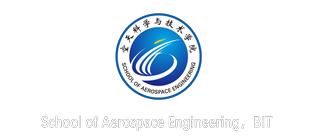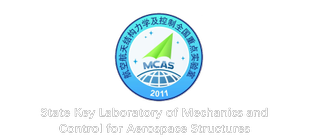预应力作用下双层石墨烯低温热振动
刘汝盟,王立峰
摘要:热振动对纳尺度器件动力学特性有着重要的影响。为此,建立了预应力作用下,考虑量子效应的双层矩形石墨烯的等效连续介质模型。计算了不同预应力作用下,不同温度时双层石墨烯的固有频率和均方根振幅。双层石墨烯层间存在范德华相互作用,其同向振动固有频率与相同尺寸单层石墨烯固有频率相等,双层石墨烯存在大于同向振动频率的反向振动频率。考虑量子效应板模型得到的均方根振幅值小于结合能量均分原理板模型得到的结果。且随着温度的降低,两种板模型结果之间的差值增大,量子效应越来越明显。随着预应力的增加,双层石墨烯的固有频率值增加,均方根振幅值降低,量子效应的影响逐渐增加。预应力对同向振动的影响远大于对反向振动的影响。分析了零点能量对双层石墨烯热振动的影响,当计入零点能量后,石墨烯均方根振幅大于结合能量均分原理板模型预测的结果,且在零温时依然存在不为零的振幅。
关键词:双层石墨烯, 热振动, 范德华力, 量子效应, 板模型, 零点能量
Thermal vibration of a double-layered graphene sheet with initial stress at low temperature
Rumeng Liu, Lifeng Wang
Abstract:Thermal fluctuations play an important role in the resonance properties of low dimensional structures as they serve as acoustic and vibration sensors of micro and nano machine. The quantum effects will be obvious during the thermal vibration of nanostructures because of the high natural frequency. Graphene has novel electronic properties and superior mechanical strength. The thermal vibration problems of graphene, which can be used as nano electronic components, have attracted a lot of research interest. The influence of quantum effects for the thermal vibration of single-layered graphene has been investigated. The dynamical behaviors of the double-layered graphene are more complicated due to the van der Waals force between two layers. However, few studies about the thermal vibration of double-layered rectangle graphene considering quantum effects have been found. To this end, an equivalent plate model with quantum effects of a double-layered graphene is established. The van der Waals interaction between two adjacent layers can be simplified as Winkler type spring because the thermal amplitude of graphene is small when the temperature is very low. The nonlocal effects and initial stress of the graphene are also taken into consideration. The natural frequency and the root of mean squared (RMS) amplitude of the double-layered graphene with different initial stress in different temperatures are calculated. The in-phase vibration mode and anti-phase vibration mode can be obtained from thermal vibration of the double-layered graphene. The natural frequency of the in-phase vibration of the double-layered graphene is the same as the natural frequency of the single-layered graphene with the same size. The natural frequency of the anti-phase vibration is larger than the in-phase vibration frequency. The RMS amplitude obtained by the plate model considering quantum effects is smaller than that obtained by the plate model together with the law of energy equipartition. The different of these two models becomes more obvious at the lower temperature. The RMS amplitude of the anti-phase vibration is smaller than the in-phase vibration RMS amplitude. The peak values of the RMS amplitude of the anti-phase vibration in different models are very close because the natural frequency of anti-phase vibration increases slowly with the increasing of model. The natural frequency of the in-phase vibration will increase with increasing of the initial stress, while the RMS amplitude of the in-phase vibration will decrease. However, the changes of the natural frequency and the RMS amplitude of the anti-phase vibration are very small when the initial stress changes. The initial stress has more significant influence for the in-phase vibration than the anti-phase vibration. The effect of zero-point energy for the thermal vibration of the double-layered graphene is also investigated. If the zero-point energy is taken into consideration to the mean modal energy, the RMS amplitude obtained by the plate model considering quantum effects is larger than that obtained by the plate model together with the law of energy equipartition in a wide range. The difference is obvious when the temperature is very low. Besides, the RMS amplitude of the graphene is not zero at the temperature of 0 K.
Keyword:double-layered graphene, thermal vibration, van der Waals’ force, quantum effects, plate model, zero-point energy
原文链接:http://engine.scichina.com/publisher/scp/journal/CSB/62/4/10.1360/N972016-00927?slug=fulltext





